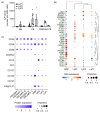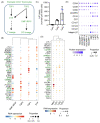Circulating IRF8-expressing CD123+CD127+ lymphoid progenitors: key players in human hematopoiesis
- PMID: 37591714
- PMCID: PMC7614993
- DOI: 10.1016/j.it.2023.07.004
Circulating IRF8-expressing CD123+CD127+ lymphoid progenitors: key players in human hematopoiesis
Abstract
Lymphopoiesis is the process in which B and T cells, and innate lymphoid cells (ILCs) develop from hematopoietic progenitors that exhibit early lymphoid priming. The branching points where lymphoid-primed human progenitors are further specified to B/T/ILC differentiation trajectories remain unclear. Here, we discuss the emerging role of interferon regulatory factor (IRF)8 as a key factor to bridge human lymphoid and dendritic cell (DC) differentiation, and the current evidence for the existence of circulating and tissue-resident CD123+CD127+ lymphoid progenitors. We propose a model whereby DC/B/T/ILC lineage programs in circulating CD123+CD127+ lymphoid progenitors are expressed in balance. Upon tissue seeding, the tissue microenvironment tilts this molecular balance towards a specific lineage, thereby determining in vivo lineage fates. Finally, we discuss the translational implication of these lymphoid precursors.
Keywords: IRF8; hematopoiesis; hematopoietic tissues; human; lineage cell fate; lymphoid progenitor cells.
Copyright © 2023 Elsevier Ltd. All rights reserved.
Conflict of interest statement
Declaration of interests No interests are declared.
Figures





Similar articles
-
Molecular and Functional Characterization of Lymphoid Progenitor Subsets Reveals a Bipartite Architecture of Human Lymphopoiesis.Immunity. 2017 Oct 17;47(4):680-696.e8. doi: 10.1016/j.immuni.2017.09.009. Immunity. 2017. PMID: 29045900
-
Differential IRF8 Transcription Factor Requirement Defines Two Pathways of Dendritic Cell Development in Humans.Immunity. 2020 Aug 18;53(2):353-370.e8. doi: 10.1016/j.immuni.2020.07.003. Epub 2020 Jul 30. Immunity. 2020. PMID: 32735845 Free PMC article.
-
IRF-8 extinguishes neutrophil production and promotes dendritic cell lineage commitment in both myeloid and lymphoid mouse progenitors.Blood. 2012 Mar 1;119(9):2003-12. doi: 10.1182/blood-2011-06-364976. Epub 2012 Jan 11. Blood. 2012. PMID: 22238324 Free PMC article.
-
Innate lymphoid cell development.J Allergy Clin Immunol. 2021 May;147(5):1549-1560. doi: 10.1016/j.jaci.2021.03.009. J Allergy Clin Immunol. 2021. PMID: 33965092 Review.
-
ILC-poiesis: Ensuring tissue ILC differentiation at the right place and time.Eur J Immunol. 2019 Jan;49(1):11-18. doi: 10.1002/eji.201747294. Epub 2018 Nov 2. Eur J Immunol. 2019. PMID: 30350853 Review.
Cited by
-
The roles of IRF8 in nonspecific orbital inflammation: an integrated analysis by bioinformatics and machine learning.J Ophthalmic Inflamm Infect. 2024 Jun 20;14(1):29. doi: 10.1186/s12348-024-00410-4. J Ophthalmic Inflamm Infect. 2024. PMID: 38900395 Free PMC article.
-
Deciphering the Complexities of Adult Human Steady State and Stress-Induced Hematopoiesis: Progress and Challenges.Int J Mol Sci. 2025 Jan 14;26(2):671. doi: 10.3390/ijms26020671. Int J Mol Sci. 2025. PMID: 39859383 Free PMC article. Review.
-
Ex vivo-generated lymphoid progenitors encompass both T cell and innate lymphoid cell fates.Front Immunol. 2025 Jul 23;16:1617707. doi: 10.3389/fimmu.2025.1617707. eCollection 2025. Front Immunol. 2025. PMID: 40771806 Free PMC article.
-
Comprehensive analysis of human monocyte subsets using full-spectrum flow cytometry and hierarchical marker clustering.Front Immunol. 2024 Apr 29;15:1405249. doi: 10.3389/fimmu.2024.1405249. eCollection 2024. Front Immunol. 2024. PMID: 38742110 Free PMC article.
-
Plasticity of myeloid-derived suppressor cells in cancer and cancer therapy.Oncol Res. 2025 Jun 26;33(7):1581-1592. doi: 10.32604/or.2025.060063. eCollection 2025. Oncol Res. 2025. PMID: 40612857 Free PMC article. Review.
References
-
- Jacobsen SEW, Nerlov C. Haematopoiesis in the era of advanced single-cell technologies. Nat Cell Biol. 2019;21:2–8. - PubMed
Publication types
MeSH terms
Substances
Grants and funding
LinkOut - more resources
Full Text Sources
Molecular Biology Databases

